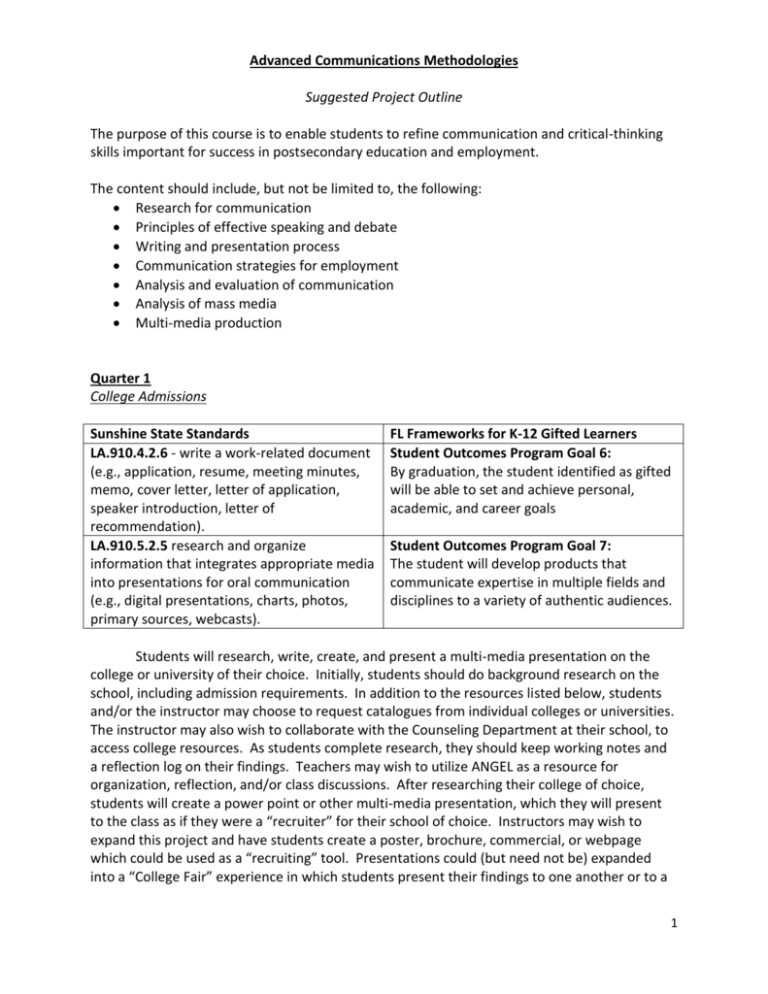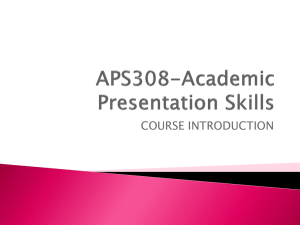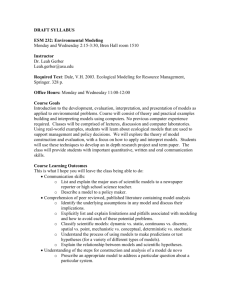Advanced Communications Methodologies Suggested Project
advertisement

Advanced Communications Methodologies Suggested Project Outline The purpose of this course is to enable students to refine communication and critical-thinking skills important for success in postsecondary education and employment. The content should include, but not be limited to, the following: Research for communication Principles of effective speaking and debate Writing and presentation process Communication strategies for employment Analysis and evaluation of communication Analysis of mass media Multi-media production Quarter 1 College Admissions Sunshine State Standards LA.910.4.2.6 - write a work-related document (e.g., application, resume, meeting minutes, memo, cover letter, letter of application, speaker introduction, letter of recommendation). LA.910.5.2.5 research and organize information that integrates appropriate media into presentations for oral communication (e.g., digital presentations, charts, photos, primary sources, webcasts). FL Frameworks for K-12 Gifted Learners Student Outcomes Program Goal 6: By graduation, the student identified as gifted will be able to set and achieve personal, academic, and career goals Student Outcomes Program Goal 7: The student will develop products that communicate expertise in multiple fields and disciplines to a variety of authentic audiences. Students will research, write, create, and present a multi-media presentation on the college or university of their choice. Initially, students should do background research on the school, including admission requirements. In addition to the resources listed below, students and/or the instructor may choose to request catalogues from individual colleges or universities. The instructor may also wish to collaborate with the Counseling Department at their school, to access college resources. As students complete research, they should keep working notes and a reflection log on their findings. Teachers may wish to utilize ANGEL as a resource for organization, reflection, and/or class discussions. After researching their college of choice, students will create a power point or other multi-media presentation, which they will present to the class as if they were a “recruiter” for their school of choice. Instructors may wish to expand this project and have students create a poster, brochure, commercial, or webpage which could be used as a “recruiting” tool. Presentations could (but need not be) expanded into a “College Fair” experience in which students present their findings to one another or to a 1 larger group of students. After each presentation, students should be prepared to answer questions from both the instructor and/or other students in a carefully researched way. Next, students should research the college application process (See resources below.) Students will fill out the application of their chosen college or university and complete the accompanying essay, if available. (If an essay prompt is not available, the instructor should provide a comparable prompt for the student to complete.) The instructor will provide background, modeling, and scaffolding for the task of completing a college admission essay. Students will draft, revise, and edit their essays before submission. After students have completed their presentations, watched the presentations of the classmates, and completed the “application” process, they should be encouraged to reflect on what they have learned. The instructor may choose to use a classroom discussion, a Socratic seminar, an ANGEL blog, journaling, or another structure to facilitate students’ reflections. Suggested Resources: FACTS.ORG www.facts.org A to Z Colleges www.a2zcolleges.com EduRegistry www.eduregistry.org Study Guide Zone www.studyguidezone.com o Choose “College Tips” Education Atlas www.educationatlas.com o Choose “Colleges and Universities.” 2 Quarter 2 Public Forum Debate Sunshine State Standards LA.C.3.4.4 apply oral communication skills to interviews, group presentations, formal presentations, and impromptu situations FL Frameworks for K-12 Gifted Learners Student Outcomes Program Goal 5: By graduation, the student identified as gifted will be able to assume leadership and participatory roles in both gifted and heterogeneous group learning situations LA.C.3.4.5 develop and sustain a line of argument and provide appropriate support Student Outcomes Program Goal 4 : By graduation, the student identified as gifted will be able to think creatively and critically to identify and solve real-world problems The instructor will explain the rules and requirements of a public forum debate. A public forum debate is a debate in which one team supports and the other team rejects a position presented in a resolution. The clash of ideas must be communicated in a persuasive manner to the non-specialist judge. With the class, the instructor will create a list of topics based on current events or universal topics of interests. Student groups will chose a chosen topic of debate and pick a pro or con view. Groups will conduct research on their view of the topic and prepare an x-minute speech with points of argument. The opposing group will present their x-minute rejection. (It is at the teacher’s discretion to determine the length of time for the debate arguments.) The debate should display solid logic, reasoning, and analysis; utilize evidence, but not be driven by it; present a clash of ideas; counter the arguments of the opponents; and communicate ideas with clarity, organization, eloquence, and professional decorum. Suggested Resources: i claim: Visualizing Argument DVD by Patrick Clauss Collier County Public Schools Speech and Debate Rubrics o < http://www.collier.k12.fl.us/candi/langarts/docs/Speech%20Guide.pdf> Collier County Public Schools Debate Guide o <http://www.collierschools.com/english/la/docs/Debate%20Guide.pdf> International Debate Education Association: o <http://www.idebate.org> Collier County Public Schools Subscription Sites: o Gale, Grolier, World Book Online, SIRS Renaissance 3 Quarter 3 Career Exploration Sunshine State Standards LA.A.1.4.3 refine vocabulary for interpersonal, academic, and workplace situations, including figurative, idiomatic, and technical meanings LA.C.3.4.4 apply oral communication skills to interviews, group presentations, formal presentations, and impromptu situations FL Frameworks for K-12 Gifted Learners Student Outcomes Program Goal 6: By graduation, the student identified as gifted will be able to set and achieve personal, academic, and career goals. Student Outcomes Program Goal 7: By graduation, the student identified as gifted will be able to develop and deliver a variety of authentic products / performances that demonstrate understanding in multiple fields / disciplines. Students will research a career of their choice to investigate. The instructor may wish to begin the project by having students complete the “Career Clusters Interest Survey.” (See link below.) The instructor, if he or she wishes, may find representatives in the community to provide information for the students. Students may also locate and utilize first-hand sources for their research. The instructor may also wish to utilize the resources available through the college or career counselor at their school. Students should research the education needed to attain entry to their career of choice, the benefits and/or compensation for the career, and / or practitioners who have had success in the field. Suggested components include having students complete or conduct the following: Writing a letter of introduction Constructing a resume Conducting an interview Drafting a job description Creating a multi-media persuasive recruitment presentation (The instructor may choose to format presentations as Career Fair booths.) Teacher Resources: FACTS.ORG: Choose the “high school students” tab and explore the “Explore Careers, Career Development” area for a wealth of resources. The “Related Links and Resources” tab includes a wealth of career information. The link to the “Career Clusters Interest Survey” is provided below. o http://files.facts.usf.edu/pdfDocuments/career/Career_Cruiser.pdf#InterestSurvey o <www.facts.org> States’ Career Cluster Initiative: This is the official website for the States' Career Clusters Initiative (SCCI). This website serves as a clearinghouse for Career Clusters research, products, services and technical assistance for implementation of the States' Career Clusters Framework for lifelong learning. o <http://www.careerclusters.org/index.php> Ed.gov: This site includes archived information from the U.S. government for high school and college students who are investigating career planning. o <http://www.ed.gov/students/prep/college/thinkcollege/highschool/edlite-career.html> 4 Quarter 4: Culminating Activity Pre-Laureate Presentation Use the Pre-Laureate Research Development Program available through the Gifted Department website. Instructors will find detailed information about the Pre-Laureate program on the “Teacher” tab. o http://www.collier.k12.fl.us/gifted/ Use the Pre-Laureate MLA Style 6-Point Rubric to develop an appropriate rubric. (Available within the Pre-Laureate curriculum) Instructors may wish to utilize ANGEL to communicate with students and parents, organize resources, and/or develop a project rubric. o http://angel.collier.k12.fl.us Utilize the “CCPS Research Process” website, available through Destiny. (This resource is under construction but will be available during the 2009-10 school year. Speak to your Media Specialist for details.) Research Paper The instructor will introduce interdisciplinary topics of interest. Within the 9th grade team, teachers may wish to collaborate, in order to decide on a focus for students’ Pre-Laureate presentations. The Media Specialist will assist student in gathering related books, magazines, periodicals and online sources. The teacher may wish to invite the Media Specialist to present students with an overview of the districts’ online resources for research. Students will choose a topic of interest and begin a reflection log, which will be kept throughout the Pre-Laureate process. Students will create and share a working thesis statement. (If they are available, the teacher may wish to share previous student-written research papers.) The instructor will provide students with a variation of the Pre-Laureate MLA Style 6-Point Rubric for student reference. Students will continue to gather and take notes on research, while documenting at least 7 sources to cite. While continuing to gather research and document sources, students will draft their introduction. An Annotated Bibliography will be created, with documented MLA sources. Using appropriate graphic organizers and outlines, students will organize their information and begin drafting their body paragraphs, with a final total of 7 + pages. Students will revisit their thesis, introduction and draft their conclusion. During the revision of the final draft, using the provided rubric, students will create a Works Cited page. Upon submission of the final research paper, students will submit their reflection log and will present their findings, incorporating the multi-media component of their research process for presentation. 5




